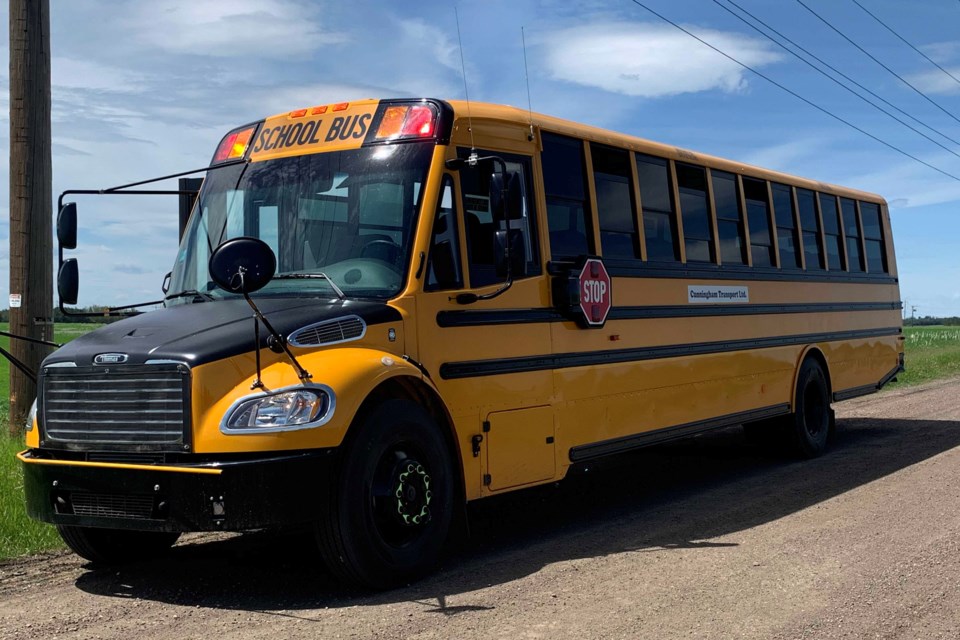St. Albert families who use the bus to get their children to and from school will notice a few changes this fall, such as new loading and unloading protocols, assigned seating and keeping an empty seat – a "protective zone" – behind the driver.
Though details are yet to be spelled out, bus companies are proactively readying for the new normal, according to Cunningham Transport general manager Laura Doroshenko. That means sourcing personal protective equipment (PPE) like face shields, masks and gloves for drivers, and sanitizers and sprays for high touch-point surfaces, before school divisions mandate what they need on the bus to start the school year.
Cunningham Transport handles all the main school routes for St. Albert Public and Greater St. Albert Catholic.
"We're anticipating the scenarios: what if a child gets COVID and is sick on the bus? What should our cleaning kit look like? There are a lot of unknowns and it'll be a new normal, but we're up for the challenge," said Doroshenko, adding the cost of new safety precautions will be significant and is something to further discuss with school boards and, ultimately, the provincial government.
She said back-to-school preparation alone will come with a price tag of about $10,000 for the bus fleet.
"Making these changes is a huge financial burden, so those conversations will come, but you can't put a price on everyone's health and safety," she said. "For now, we're just excited to get everybody back. Our drivers really miss the kids."
David Smith, occupational health, safety and environment manager with Cunningham Transport, said he's thinking outside the box when looking at how to best clean buses going forward.
"We're planning a phased cleaning. Drivers will clean their bus after every pick-up and drop-off, back to front, with a hospital-grade disinfecting spray. Then every 48 hours, the buses will get a deep cleaning with a fogging machine. We're getting estimates on those now," he said. "There's no cutting corners on safety. We know that on September 1, we're sending out 100 per cent disinfected buses."
While the provincial government's guide for resuming classes under scenario one (a "near-normal" return) has several specific recommendations, including implementing social distancing techniques and staggering drop-off and pick-up times and locations to limit contact between students, parents and staff, St. Albert Public says the funding isn't there to offer staggered routes with reduced ridership.
"Our bus volumes and routes will remain the same – 2,500 students total, plus those on 37 special needs buses via Southland Transport – so physical distancing won't be possible while on the bus. But we're taking precautions when kids get on and off," said Paula Power, communications manager for St. Albert Public. "Students will pass each other as little as possible, with those (on first) heading to the back of the bus and getting off last. Siblings will sit together, too, and we'll have a seating plan to help with contact tracing if a student gets COVID-19."
St. Albert Public transportation manager Kris Salerno said the school division would provide bus companies and students with guidelines of what they expect.
"It'll be harder with elementary school kids, who tend to touch windows and backpacks and need reminders to keep their hands to themselves. The older kids are usually on their phones with their heads down, so they're not as much of a concern," Salerno said.
While St. Albert Public Schools is expecting a three-per-cent increase in enrollment this year, funding hasn't returned to pre-UCP levels. Bus fees for families are set to stay the same for this school year.
"We already run a transportation deficit. The government says funding is increased for schools to be able to deal with COVID-19, but funding was reduced the year before, and so we're not even back to funding levels from the year before that."
In trying to anticipate the 'what if' scenarios, Power said she can see an issue with increased absenteeism of teachers and bus drivers if they test positive for COVID-19.
"It's a real concern. Bus companies sometimes have trouble covering routes in normal times, but what if a driver is off with COVID-19 symptoms and no one is available to finish a route?"
When buses are running late or are cancelled for mechanical or weather emergencies, the division already uses several methods to notify parents: text, email, phone and an app.
Doroshenko said Cunningham Transport has new protocols in place to minimize the risk of that happening. When coming to work, drivers will now get a temperature check and questionnaire at the bus yard gates before they're able to pick up a cleaning kit and proceed to their bus.
"In regular flu seasons, we already deal with being down drivers – the same goes for January/February when people go away on winter trips," she said. "We allow for that, and have spare drivers on staff. But we're also a licensed training school for Class 2 drivers, and we're always looking for Class 1 and 2 drivers. We encourage people to apply."




